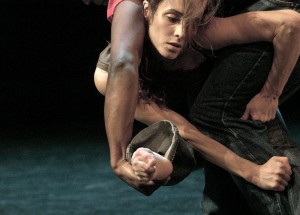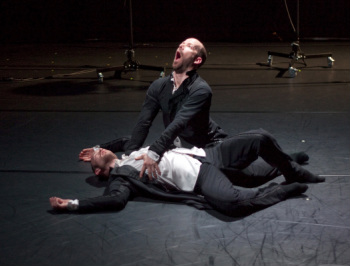By Rachel Straus
Seeing The Matrix in 1999 made my heart sink. It wasn’t Keanu Reeves’s acting that depressed me; it was the advances in live action animation. In the final battle scene, Reeves and Hugo Weaving engage in mortal combat. With millisecond timing, they evade each other’s rocket-force punches by bending their head to their feet (like a slinky) and by levitating into the air (like a twister). How, I thought, can dance compete with this technological display of bodily virtuosity?
Then, ten years later, I saw Crystal Pite’s Dark Matters. Her choreography augured a new movement style, a Matrix-esque sense of physical wonder. On January 24 at Baryshnikov Arts Center (BAC), Pite’s choreography enthralled the audience. At the end of The You Show, made in 2010 with her company Kidd Pivot Frankfurt RM, Pite and her eight dancers received a standing ovation.
Pite’s style is not lyrically based (like Isadora Duncan), predicated on the balletic idiom (as with George Balanchine), psychologically motivated (in the case of Martha Graham) or in rebellion against concert tradition (Judson Dance Theatre). Its subject is the futuristic body—that’s faster and more intricate than machines. In the beginning of The You Show, Peter Chu falls backward in slow motion onto the floor; he folds like an accordion. Later Cindy Salgado undulates her prone body off the floor—in a blink of an eye. These moments don’t look like stunt work. They are part of a skein of movement, which occurs in inner-space pitch darkness (thanks to lighting designer Robert Sondergaard). They create a dream-like world, which seems only possible in the imagination.
Because Kidd Pivot is celebrating its tenth anniversary, has been a resident company at Künstlerhaus Mousonturm in Frankfurt since 2010, and is only now giving its New York performance debut, Pite has become something of cause célèbre for New York dance-interested audiences. In describing her style, writers often allude to her seven years dancing in William Forsythe’s Ballet Frankfurt. But it’s reductive to see Pite’s work as merely a derivation of Forsythe’s. While Forsythe’s performers looked loopy and frenetic in recent works presented in New York (Three Atmospheric Studies and I don’t believe in outer space), Pite dancers never look out of control. Rather than resembling epileptic victims, they resemble Marine fighters.
In the program notes, Pite writes how The You Show derives from her “fascination with familiar storylines of love, conflict and loss, and the body’s role in providing the illustrative shapes of those stories.” While some observers might find Pite’s relationship theme as captivating as her movement vocabulary, I did not. The three sets of duets, and one group dance, all ended the same way: the significant other leaves the beloved. These departures began to feel a bit pat. What was not pat was Pite’s definition of a relationship in section two, titled “The Other You.” In the duet, Eric Beauchesne and Jiří Pokorný are the same people. Pokorný pushes his alter ego, Beauchesne, around. He resembles a ventriloquist with his dummy. The duet, to an array of atmospheric and classical music, including Beethoven’s Piano Sonata No. 14 in C Sharp Minor, seemed to reveal a deeper message: The dancer fights each day with her self. The enemy isn’t the other person; it’s the voice that says, “I want to rest!”
Pite makes fun of this dancer-as-fighter conceit in the last section of The You Show. There, Jermaine Maurice Spivey dons a red cape and becomes a super hero. Later he fights Tron-style with his mate (Sandra Marín Garcia). Their mechanized armor is composed out of three dancers who weld their bodies to either Spivey or Garcia’s. The result is that Spivey and Garcia’s body mass quadruples to resemble armor-clad gladiators. Audience hooted with laughter, when they recognized that Pite was satirizing her combative style. But after this scene, Pite returned to her ardent tone. Four women danced Pite’s electric-shock gestures and buttery, spiraling, back bending floor-to-standing phrases with total seriousness. Their commitment to pushing their bodies beyond what most dancers deem possible is what made Pite’s The You Show entirely captivating. It’s what makes Pite’s choreography part of the zeitgeist, where conversations about the the blending of man and machine abound.
Tags: Baryshnikov Arts Center, Beethoven, Cindy Salgado, Crystal Pite, Dark Matters, Eric Beauchesne, George Balanchine, Hugo Weaving, I don't believe in outer space, Isadora Duncan, Jermaine Maurice Spivey, Jiří Pokorný, Judson Dance Theatre, Keanu Reeves, Kidd Pivot Frankfurt RM, Marines, Martha Graham, Peter Chu, Piano Sonata No. 14 in C Sharp Minor, Robert Sondergaard, Sandra Marin Garcia, The Matrix, The You Show, Three Atmospheric Studies, William Forsythe

